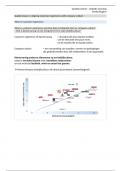Samenvatting
Summary Corporate Finance, Fundamentals of Corporate Finance, Global Edition, ISBN: 9781292215075 Corporate Finance
- Vak
- Instelling
- Boek
This summary contains all necessary material for the course Corporate Finance. You can ready this document instead of the book, as it is very in depth summary. Main book: Corporate Finance, Fundamentals of Corporate Finance. Chapter 1-12, 28
[Meer zien]






